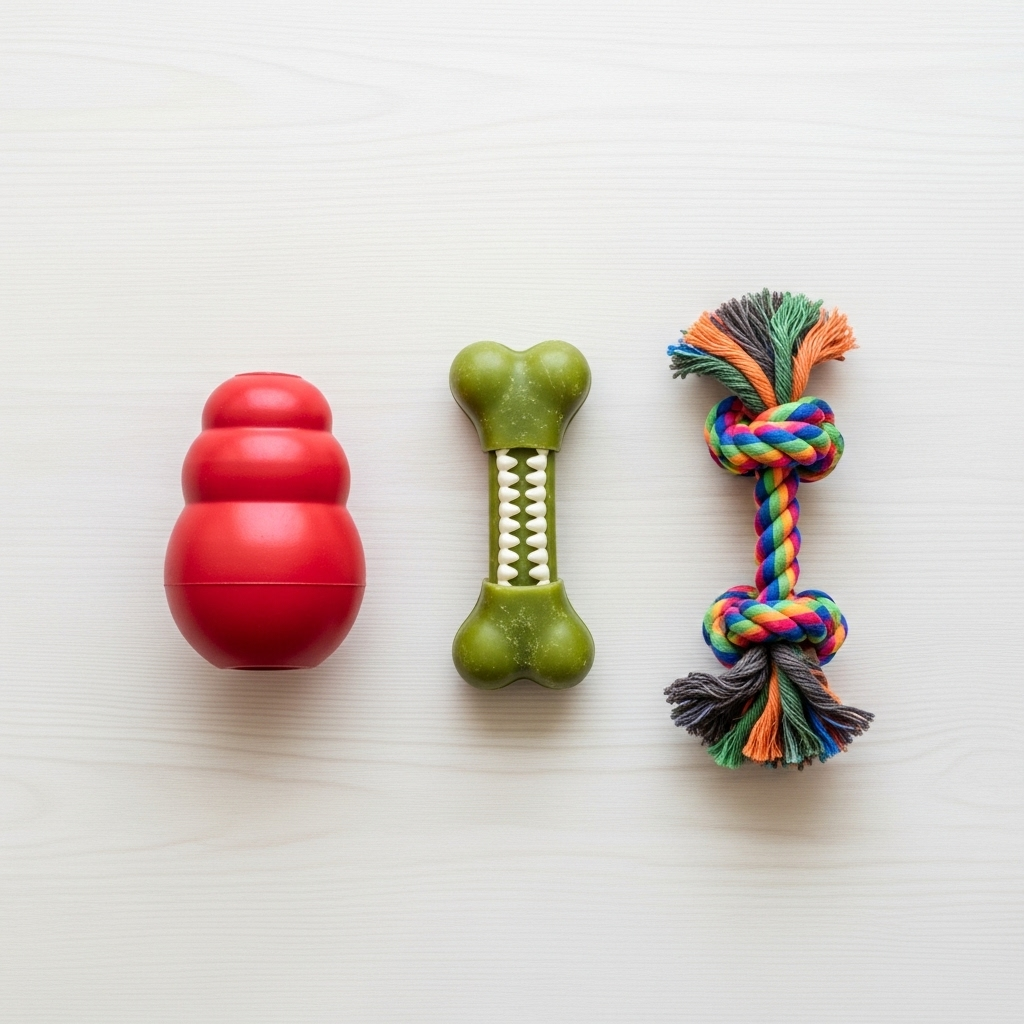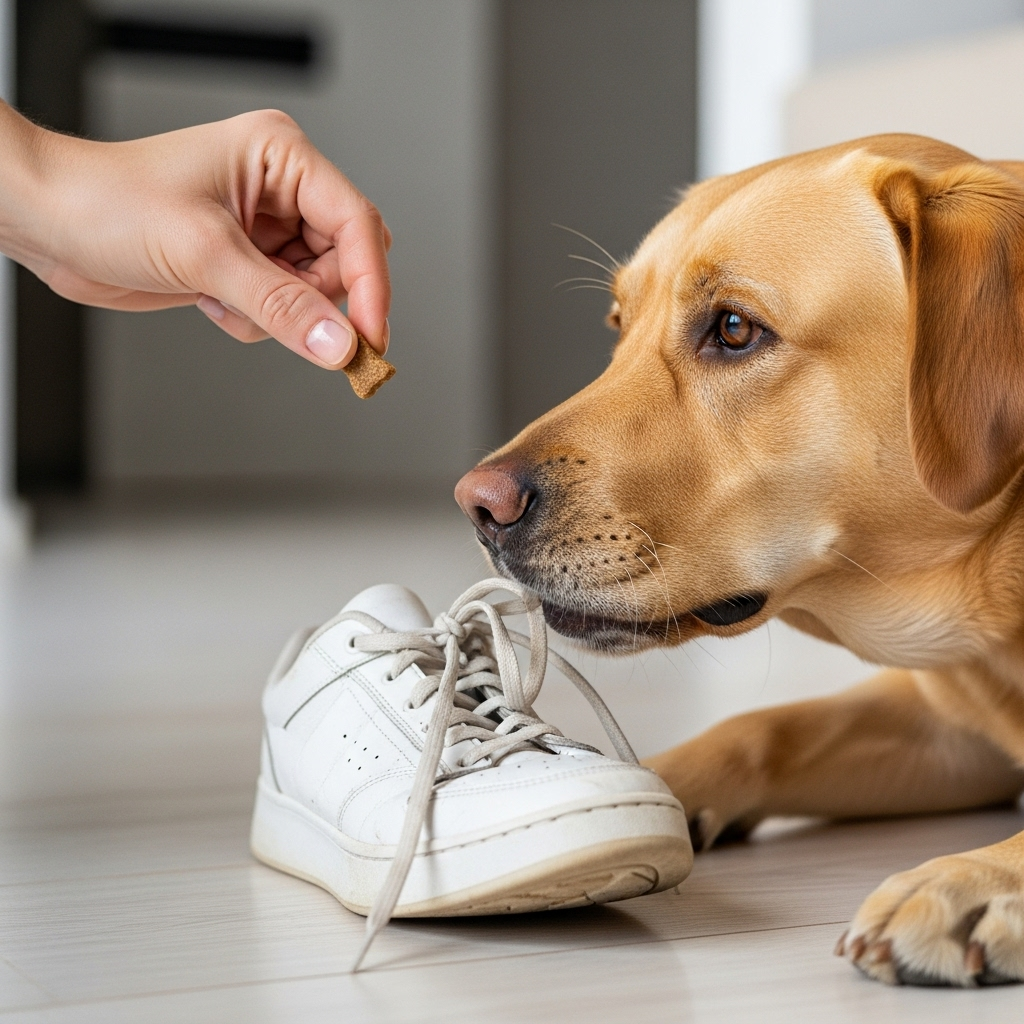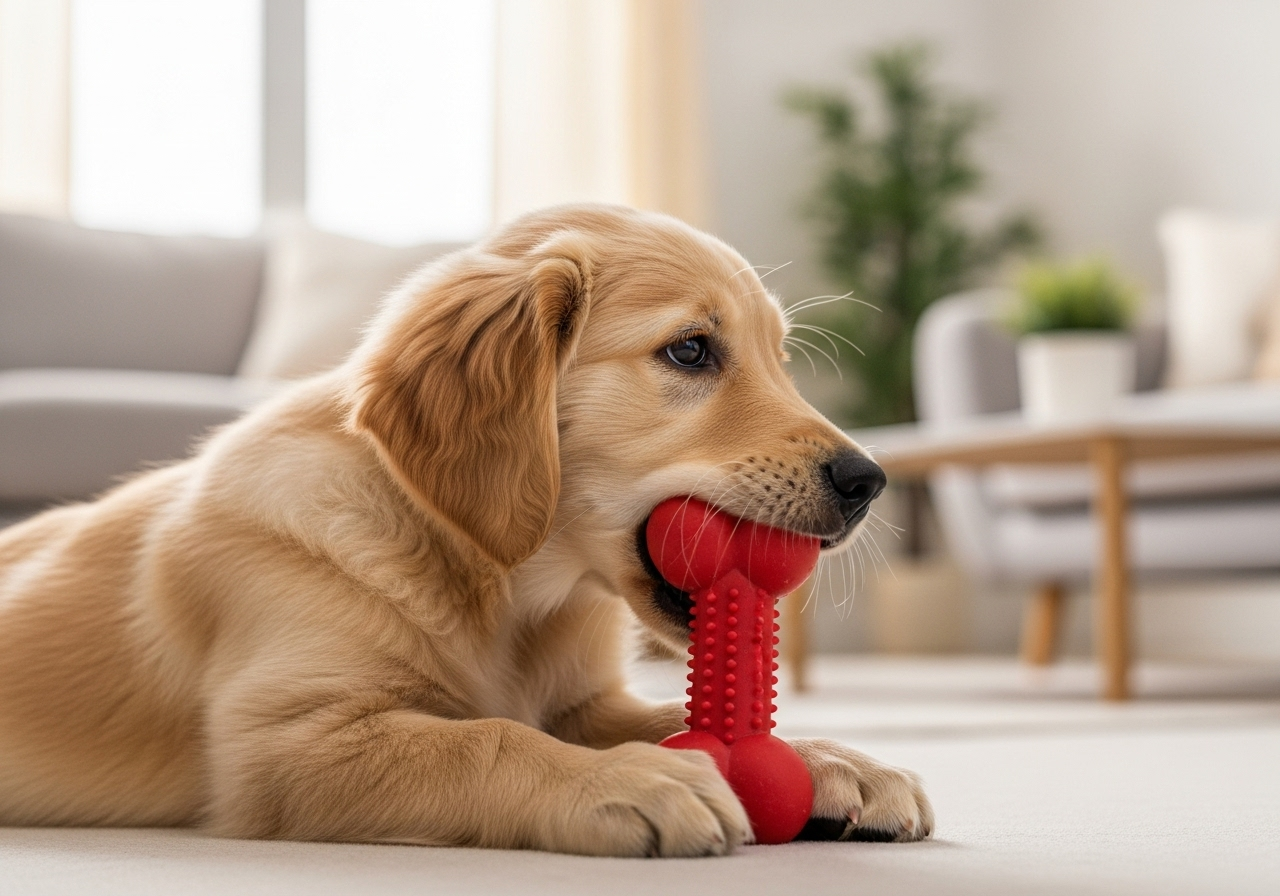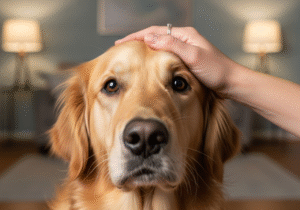Medical Disclaimer: This article is for informational purposes only and is not a substitute for professional veterinary advice. Please consult your veterinarian for any health concerns regarding your pet.
Key Takeaways
Is your dog chewing furniture? This behaviour often stems from teething in puppies, boredom, separation anxiety, or even underlying medical issues. The first step is to identify the root cause. The most effective solutions involve managing your dog’s environment by removing temptations, providing plenty of appropriate chew toys, and increasing daily physical and mental exercise. Training commands like “Leave It” are crucial. If the chewing is linked to anxiety or you suspect a health problem, a visit to your veterinarian is the most important step to resolving the destructive behaviour for good.
Table of Contents
It’s a frustrating moment every pet owner dreads: coming home to discover your beloved couch cushion de-stuffed or your antique table legs covered in tiny teeth marks. I’ve seen the exasperation on countless faces in my Ottawa clinic. A dog chewing furniture isn’t trying to be bad; they’re trying to communicate a need. Let’s figure out what that is.
Why Is My Dog Chewing Furniture? Uncovering the Root Cause
You can also visit: https://doglifeexpert.com/calming-anxious-dogs-10-proven-techniques/

Understanding the “why” behind your dog chewing furniture is the first, and most critical, step toward finding a lasting solution. From puppy antics to more complex anxieties, the reasons are varied.
Teething Troubles in Puppies
If your furry friend is under six months old, teething is the most likely culprit. Just like human babies, puppies experience discomfort as their adult teeth come in. Chewing provides relief for their sore gums. While this is a normal developmental stage, it’s our job to teach them what is and isn’t acceptable to chew on. This early guidance is key to preventing a long-term dog chewing furniture problem.
Boredom and a Lack of Mental Stimulation
In my years of practice, boredom is one of the top reasons I see for a dog chewing furniture. A dog without a “job” will often invent one, and dismantling your armchair can seem like a great way to pass the time. Dogs are intelligent animals that need outlets for their mental and physical energy. As research in the Journal of the American Veterinary Medical Association highlights, providing environmental enrichment is not just a luxury; it’s a crucial part of preventing behavioural problems like destructive chewing. Without it, you’ll likely continue to find your dog chewing furniture.
Separation Anxiety and Stress
For some dogs, chewing is a coping mechanism for anxiety, especially when left alone. A dog chewing furniture only when you’re away from home is a classic sign of separation anxiety. This isn’t just bad behavior; it’s a genuine panic response. These dogs may also exhibit other signs like pacing, excessive barking, or having accidents indoors. According to the Saunders Manual of Small Animal Practice, managing separation anxiety often requires a multi-faceted approach, including behaviour modification and sometimes medication.
Medical Reasons Your Dog is Chewing Furniture
While less common, there are medical reasons that can lead to a dog chewing furniture. Pica, a condition where dogs crave and ingest non-food items, can be linked to nutritional deficiencies or gastrointestinal issues. In some cases, as noted in Blackwell’s Five-Minute Veterinary Consult: Canine and Feline, this compulsive behaviour can have deep-seated medical roots that require a full diagnostic workup. Any sudden change in behaviour warrants a call to your vet to rule out an underlying health problem.
Your 5-Minute At-Home Checklist to Tackle Destructive Chewing
Before diving into training, run through this quick checklist to see if you can spot the cause of your dog chewing furniture.
- When does it happen? (Only when I’m gone? When I’m home but busy?)
- What is being chewed? (Is it always wood? Fabric? A mix?)
- How old is my dog? (Is teething a possibility?)
- How much exercise did my dog get today? (A short leash walk or a long run at the park?)
- Are there enough toys? (Are they interesting and accessible?)
- Has anything changed recently? (A new schedule? A move? A new family member?)
Answering these can provide immediate clues and help you focus your efforts to stop your dog chewing furniture.
7 Proven Steps to Stop Your Dog Chewing Furniture for Good
Once you have an idea of the cause, you can implement a clear, consistent plan. Tackling a dog chewing furniture issue requires patience and a combination of management, training, and enrichment.
Step 1: Dog-Proof Your Home Environment
Management is your first line of defence. An ounce of prevention is worth a pound of chewed-up table legs.
- Restrict Access: Use baby gates, exercise pens, or close doors to keep your dog out of rooms with tempting furniture, especially when you can’t supervise them.
- Remove Temptations: Keep coffee tables and end tables clear of items like remote controls, books, and shoes.
- Tuck Away Wires: Secure electrical cords to prevent dangerous chewing.
Step 2: Provide a Variety of Safe Chew Toys

You can’t just say “no,” you have to offer a better “yes.” The goal is to make their toys far more interesting than your furniture.
- Rotate Toys: Keep a stash of toys and only leave a few out at a time, rotating them every few days to maintain novelty.
- Offer Variety: Provide different textures and types, such as durable rubber toys (great for stuffing with treats), dental chews, and puzzle toys.
- Make Them High-Value: Stuff a puzzle toy with a bit of peanut butter or their favourite treat. This instantly makes the toy more appealing than a boring chair leg.
Step 3: Increase Physical Exercise and Mental Enrichment
A tired dog is a well-behaved dog. For many clients I see, simply increasing exercise is the magic bullet that solves the problem of a dog chewing furniture.
- Physical Activity: Ensure your dog gets at least 30-60 minutes of brisk physical activity daily. This could be a long walk, a game of fetch, or a run at a dog park.
- Mental Workouts: Five to ten minutes of training sessions or a food puzzle can tire a dog out as much as a 30-minute walk.
Step 4: Use Deterrent Sprays Strategically
Commercially available anti-chew sprays with a bitter taste can be a useful tool, but they are not a standalone solution. They work best when used in conjunction with training to make the furniture an unpleasant option while you teach your dog what to chew. Always test the spray on an inconspicuous area of the furniture first.
Step 5: Master “Leave It” and Redirection

Positive reinforcement training is essential. When you catch your dog chewing furniture, don’t scold them.
- Interrupt: Make a calm but sharp noise (like “Ah-ah!”).
- Redirect: The moment they look at you, offer them an appropriate chew toy.
- Praise: When they take the toy, praise them enthusiastically (“Good dog!”).
Teaching a solid “Leave It” command is invaluable for preventing a dog from chewing furniture and keeping them safe from other hazards.
Step 6: Rule Out Separation Anxiety
If you suspect anxiety is the cause, the approach needs to be more nuanced. The goal is to teach your dog that being alone is safe and not a cause for panic. According to The Merck Veterinary Manual, addressing these compulsive behaviours often involves creating positive associations with your departure. Start with very short absences and gradually increase the duration. For severe cases, consulting a veterinary behaviourist or your family vet is crucial.
Step 7: When to See Your Veterinarian

If you’ve tried these steps and the dog chewing furniture problem persists, or if it started suddenly in an adult dog, it’s time to book a vet visit. We can help rule out underlying medical issues and, if needed, discuss anti-anxiety medications or refer you to a certified professional dog trainer or veterinary behaviourist for more intensive help. The Canadian Veterinary Medical Association is a great resource for finding qualified professionals.
What Does It Cost to Diagnose a Dog Chewing Furniture in Canada?
Costs can vary depending on your location and the specific tests needed. Here is a general estimate of what Canadian pet owners might expect:
| Service | Estimated Cost (CAD) | Purpose |
| Veterinary Consultation | $80 – $150 | Initial physical exam and discussion of behavioural history. |
| Basic Bloodwork | $150 – $300 | To rule out underlying metabolic or organ-related issues. |
| Veterinary Behaviourist Consult | $400 – $700+ | In-depth assessment and creation of a detailed behaviour modification plan. |
| Anti-Anxiety Medication | $50 – $150 / month | If diagnosed with a clinical anxiety disorder. |
These are estimates and do not include taxes. Prices will vary by clinic and province.
People Also Ask: FAQs About Dogs Chewing Furniture
Why has my adult dog suddenly started chewing furniture?
A sudden onset of a dog chewing furniture in an adult dog is a red flag. It could be triggered by a change in their environment (like a move or schedule change), increased stress or anxiety, or an underlying medical condition. It’s highly recommended to schedule a veterinary check-up to rule out any health problems first.
What can I put on furniture to stop my dog from chewing it?
You can use a commercial bitter apple or bitter cherry spray. These products have an unpleasant taste that deters most dogs. However, they should be used as a training aid to make the furniture less appealing while you actively teach your dog to chew on appropriate toys instead.
Is it okay to use a crate to prevent my dog from chewing furniture?
Yes, when used correctly, a crate is an excellent management tool. It provides a safe, den-like space for your dog when you cannot supervise them. The key is to make the crate a positive place with comfy bedding and special toys, never using it as a form of punishment.
Do anti-chew sprays actually work?
They work for many dogs, but not all. Some dogs don’t mind the bitter taste. Their effectiveness is highest when you combine them with positive reinforcement, making the right choice (a toy) much more rewarding than the wrong one (the sprayed furniture). They are a tool, not a complete solution for a dog chewing furniture.
A Final Word from Your Vet
Seeing your home damaged is disheartening, but remember that a dog chewing furniture is not a malicious act. It’s a cry for help, a sign of boredom, or a symptom of pain or anxiety. By approaching the problem with empathy and a clear plan, you can redirect this behaviour, strengthen your bond, and restore peace to your home. You’re not just saving your sofa; you’re building a happier, healthier life for your best friend.





Pingback: Essential Puppy Socialization Checklist to Prevent Fear 101